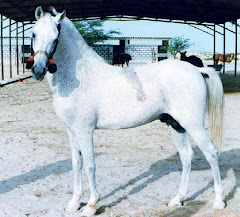
In his 17th century classic, entitled Rashaat Al-Midad Fi Al-Safinat Al-Jiad, Shaikh Muhammad ibn Muhammad ibn Muhammad ibn Muhammad ibn Ahmad Al-bakhshi Al Bakfaluni Al-Halabi presented a chapter on Arabian horse type, colors, markings, and ideals. Unless specifically referenced to another source, the reader should assume that all description of the desert type have been taken from the translation of Halabi's book and thus represent desert type as of the 17th century.
The Head
Considered as a whole, the head should be relatively long, and should not tilt to the side while the horse is running. the ears are long, thin, and pointed. The forelock is neither to thick nor to thin, the forelock should not cover the eyes. The eyes, themselves, are long. It is preferred that the eyes are free of major whiteness, blackness,or blue color. The cheeks should be long and relatively free of flesh. the nose should also be relatively long. The end of the jaw bones, The muzzle, the mouth, and the nostrils should be wide. a convex muzzle is frowned upon. The lips, tongue, and teeth should be thin. it will continue
width between the jaw bones near the throat is prized. The profile of the head should be relatively straight, and a pronounced dish is to be avoided, although the illusion of a dish caused by a prominent Jabha (outwardly bulge on the forehead ) is acceptable.
In Banu Sanhadja opinions many of the above qualities appear to be
subservient to increased air flow for the horse. For example, width between jaws, as well as a wide muzzle, mouth, and nostrils, appears to be serving the family the function nostrils appears to be serving the function of increased airflow.
The Neck:
The neck should be long in addition the neck should be thick and and wide at the base" Further,the neck should be smooth and high.
The Body:
The belly hips, and shoulders should be wide. the shoulders should also be pointed and one hip being higher than the other is dislike. The chest should be wide but should be relatively free of flesh. The ribs should be high so as to create a considerable space for the inner part of the body. the back should be short, and the withers should be relatively close to the croup. The Sahwa (i.e the place on the back where the rider would sit) should not be greatly lower than the Qatat (i.e. the place on the top line where a second rider would sit behind the primary rider). The waist (Flank) should not be protruding.
The Legs:
In general, it is preferred that the legs have some curves to them. such curving is referred to as Tajnib in the hind legs and as Tajnib in the forelegs. (note; "Tajnib" implies a view from the side, and would indicate that the hind legs should not be too upright. we are unable to supply more definition for Tahnib in English) The distance between the legs should not be long. The forearms and thighs should not be long, and the thighs should be wide and thick. Otherwise, the legs should be relatively free of flesh. The cannons and pasterns should be short, as it is stated that the four cannon bones should be close to the hooves, and the four "knees" should be close to the pasterns. The pasterns should not be upright, The hocks should be pointed and the four"knees" should be thick. the hooves should be tough, and resistant to peeling. The hooves should also be wide and shape like a cup. The hair and mane and tail should be long: the root of the tail should be short and without any pronounced curve. Body hair should be thin and short, The skin should be smooth and sleek, which is considered the mark of nobility in an Arabian horse, A low and thick boned horse is disliked. The placement of the tail should be relatively high, but should not exceed the high point of the croup.
Conclusions
Quite obviously the above description of the desert type does not give every detail that every person might want. Further some of the points may seem somewhat ambiguous, for example, exactly what is implied by Tahnib"? However,even with these limitations, some of the points presented above in the brief synopsis of desert type may be a surprise to some western readers, For example the Al-Halabi manuscript certainly contradict the notion of a tea a "teacup muzzle" other points may be equally surprising to some readers.
However, despite such surprises, the reader must bear in mind that the vast majority of the information conveyed is taken from the 17th century Arabic text on Arabian horses. In the final analysis, If we are going to value and breed for desert type, we must realize that Western travelers to the middle East may well have formulated their description of Arabian horses based upon European or American eyes and standards. In contrast, the Al Halabi manuscript presents the Arabian horse through the eye of a 17th century Arab.
finally, it should be noted that, the above description is a pretty fair fit with Bani Sham Arabians and Also with Banu Sanhadja Arabians in North America and in Syria, Jordan, and in the Mahgribi. This may not be the standard of the modern American show rings, but it is the Bedouin standard. Fortunately, The Bani Sham Arabians and Asil Desert type breeders continue to conform to the latter standard.

.jpg)



























































No comments:
Post a Comment